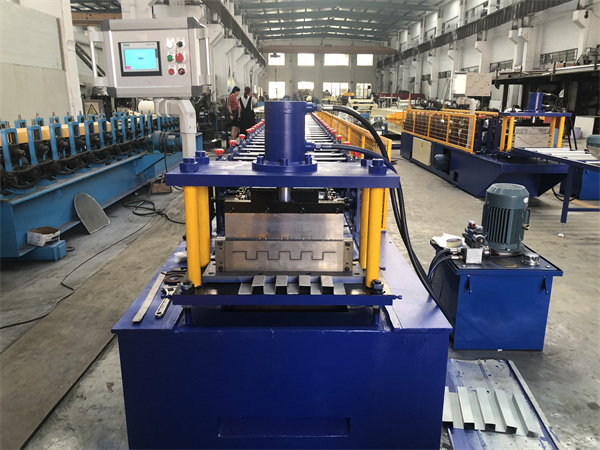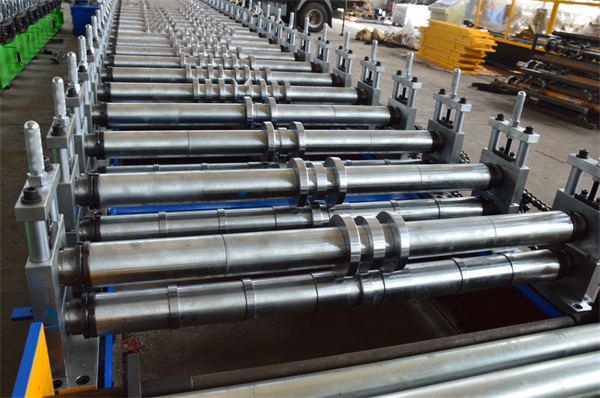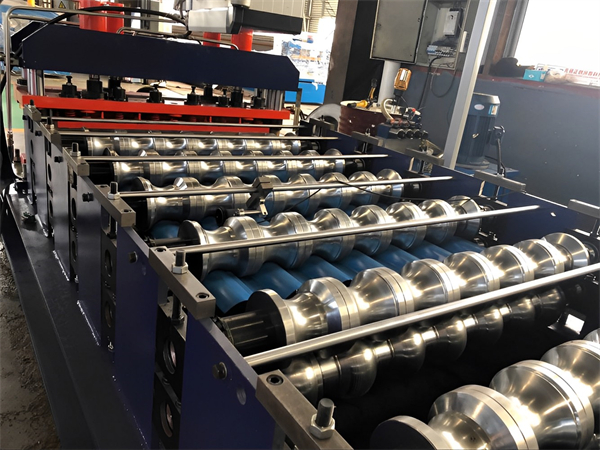Fascia roll forming machines are essential equipment for the efficient production of fascia panels used widely in the construction industry. This comprehensive guide provides a detailed overview of fascia roll formers covering their key features, types, specifications, applications, installation, operation, maintenance, suppliers, prices and more.
Overview of Fascia Roll Forming Machines
Fascia roll forming machines take flat metal coil stock and progressively bend it into custom fascia panel profiles through a series of rollers. They create lengthy, continuous panels without welding for roof edging, soffits, fascias and gutters.
Compared to other panel forming methods, roll forming is faster, more efficient and cost-effective for producing large volumes of panels in custom profiles. It delivers consistent quality and durability. Roll formed panels are lightweight yet strong and rigid.
Key benefits of fascia roll forming machines:
- High speed production of long, seamless metal fascia panels
- Ability to create custom profiles not limited to standard sizes
- Consistent panel quality and structural integrity
- Cost savings from automation and raw material efficiency
- Minimal tooling requirements for profile changeovers
- Flexibility to produce panels in different metals and colors
- Just-in-time production improves inventory management
- Safer working environment compared to fabricating on site

Types of Fascia Roll Forming Machines
There are two main types of fascia roll formers:
C-Type Fascia Roll Forming Machines
C-type roll formers have a C-shaped frame design with forming stations arranged inside the C. They utilize vertical rollers and feature a cantilevered roll stack.
Avantages :
- Empreinte compacte
- Facile à utiliser et à entretenir
- Lower cost for simple profiles
Limites :
- Limited forming capability for complex profiles
- Access inside C-frame can be restricted
O-Type Fascia Roll Forming Machines
O-type roll formers have an O-shaped frame with horizontal roller stations situated outside the O for easier access. They use pioneering wrap-around tooling for increased forming capability.
Avantages :
- Advanced roll designs produce complex profiles
- Better access to roll tooling improves changeovers
- Larger product range and customization ability
Limites :
- Larger machine footprint
- Higher initial capital cost
Hybrid Fascia Roll Forming Machines
Hybrid fascia roll formers combine vertical C-frame stations with exterior horizontal rolls. This allows forming more complex profiles than C-type machines, while maintaining a compact footprint.
Key Components of a Fascia Roll Forming Machine
Fascia roll formers are equipped with the following components:
- Dérouleur – Feeds raw coil stock into the roll forming line. Includes powered unwinding system and coil guides.
- Table d'alimentation – Provides support for coil strip entering the roll station. Keeps material aligned.
- Stations de formage de rouleaux – Progressive bending of strip through consecutive roller dies to shape profile.
- Unité de perforation – Optional for creating holes or notches in the fascia panel.
- Shearing unit – Cuts formed panels to required length after exiting the roll forming line.
- Convoyeurs – Transports panels from the line exit point. Used for stacking.
- Electrical control cabinet – Houses the automation system and controls machine operation.
Specifications of Fascia Roll Forming Machines
Fascia roll former technical specifications determine production capabilities and output quality:
| spécification | Détails |
|---|---|
| Vitesse de formage | Linear speed of panel through the roll stations, typically 10-15 m/min. Higher speed increases output. |
| Largeur de travail | Maximum panel width that can be formed, usually 650-3000 mm. Wider capacity produces more panels per coil. |
| Capacité d'épaisseur | Minimum and maximum sheet metal thickness that can be formed, generally 0.3-2.0 mm. |
| Coil ID range | Inner diameter size of coils that can be used, typically 405-610 mm. Larger ID enables longer production runs. |
| Hauteur du profil | Maximum fascia profile height that can be achieved, up to 300 mm. More roll stations allow higher profiles. |
| Number of roller dies | More stations (10-24) allow longer and more complex profiles. May include upper, lower, side and wrapping rolls. |
| Type de matériau | Common materials include steel, aluminum, zinc, copper. Some machines offer multi-metal flexibility. |
| Surface coating | Pre-painted, galvanized, stainless steel, anodized aluminum materials can be formed. |
| Perforation de trous | Optional punching unit for holes, louvres or notches if required in panel. |
| Tooling sets | Number of dedicated tooling sets for different profiles available for the machine. More tooling sets reduce changeover time. |
| Automatisation | Level of automated operation, monitoring and control features. |
| Poids de la machine | Heavier machines (6-12 tons) offer greater stability for accuracy. |
Applications and Uses of Fascia Roll Forming Machines
Fascia roll formers produce panels for the following applications:
- Roof fascias – Outer edging for roof overhangs and eaves. Provides an aesthetic finish.
- Soffites – Underside covering of overhanging roof eaves. Protects from weather.
- Gutters – Channels that collect and drain rainwater from the roof edge.
- Parapet wall cladding – Vertical metal fascia coverings on building exteriors.
- Solin de porte et de fenêtre – Weather resistant panels around openings.
- Building trim – Decorative finish trims along walls, corners or openings.
- Revêtement mural – Exterior siding panels for walls made of metal.
- Toiture – Curving panels for metal roofs.
- Signalisation – Branded fascia panels for retail and office buildings.
- Ventilated facades – Exterior cladding with airflow cavity behind.
- Sun shading – Extended fascia panels creating overhangs for shading.
With custom tooling, fascia roll forming machines allow architects the design freedom to realize unique aesthetics for buildings.

Choosing a Fascia Roll Forming Machine Supplier
Selecting the right fascia roll former supplier for your production requirements is key. Below are important factors to consider:
Qualité de la machine : The supplier should use precision engineered components from leading brands and rigorous machining standards. This ensures consistent quality panels, minimal downtime and long equipment lifespan.
Expertise technique : Look for an experienced supplier with in-depth technical know-how in fascia roll forming to provide the right machine recommendations and design support.
Customization Ability: Supplier should offer customized machine design to meet your exact fascia panel requirements rather than just pre-configured models.
Quality Certification: Reputable ISO 9001 certified suppliers adhere to strict quality control and international manufacturing standards.
** responsive Support:** Choose a supplier responsive to technical queries and service requests to minimize downtime. Quick turnaround on spare parts is vital.
Formation : Opt for suppliers who provide operator training on proper machine use, maintenance and safety procedures.
Proven Reliability: Check client references and case studies to verify supplier reputation and their machine’s reliability and durability.
Coût : Balance cost against machine quality, features and after-sales support rather than just lowest price. Consider total long term value.
Fascia Roll Forming Machine Prices
Fascia roll former prices vary based on factors like:
- Machine size and capacity
- Level of automation and additional features
- Complexity of fascia panel profile
- Raw material used – steel, aluminum etc.
- Production speed and output requirements
- Reputation and quality of equipment brand
Fourchette de prix typique :
| Type de machine | Échelle des prix |
|---|---|
| Manual C-type roll former | $8,000 – $15,000 |
| Automatic C-type roll former | $15,000 – $25,000 |
| Automatic O-type roll former | $25,000 – $50,000 |
| High-speed O-type roll former | $50,000 – $80,000 |
| Large width roll former | $80,000 – $120,000 |
| Custom large roll former | $100,000+ |
Get price quotes from minimum 3 suppliers before purchasing. Evaluate long-term costs like operation, maintenance and tooling changes rather than just unit price.
How to Install and Operate a Fascia Roll Former
Proper installation and operation maximizes productivity and longevity of your fascia roll forming machine. Here are key guidelines:
Préparation du site
- Prepare solid, level foundation to avoid vibration during operation.
- Ensure sufficient space around the equipment for safe access.
- Have required utilities like power supply and compressed air available nearby.
Positionnement
- Use castors to move the machine components into position.
- Align and bolt together the roll former sections tightly.
- Adjust roller stations to required forming profile.
Mise en service
- Verify electrical, pneumatic and hydraulic connections.
- Power up to test machinefunctions without feed stock.
- Make final calibrations to achieve desired panel profile.
Course d'essai
- Thread coil material through the decoiler, tables and roll stations.
- Run at low speed checking alignment through the sections.
- Inspect first panels to validate profile dimensions and quality.
- Make any fine adjustments to rollers before production run.
Production Operation
- Maintain consistent coil tension and alignment into the rolls.
- Periodically check panel length, punching quality and cut edge.
- Monitor for any abnormal vibrations, noises or heating up.
- Use recommended machine settings for optimal output.
- Safely collect panels exiting the line.
Maintenance préventive
- Clean machine daily removing metal dust and particles.
- Lubricate rollers, bearings, chains and guides regularly.
- Check hydraulic systems and pneumatic pressure as required.
- Inspect all assemblies for loose parts or wear periodically.
- Replace any damaged or worn components immediately.
Fascia Roll Former Maintenance Guide
Proper maintenance is crucial for smooth operation and maximum working life of fascia roll forming machines. Here are key maintenance activities and schedules to follow:
| Tâche | Fréquence | Méthode |
|---|---|---|
| Nettoyage | Quotidiennement | Remove metal chips and dust from rollers, tables, conveyors using brush and vacuum. |
| L'inspection | Quotidiennement | Check for leaks, loose parts, unusual noises. Monitor coil line tension. |
| Lubrification | Hebdomadaire | Apply machine oil to bearings, chains, guides. Grease gear boxes if equipped. |
| Roller Maintenance | Mensuel | Examine rollers for wear or damage. Replace immediately if found. |
| Hydraulics Inspection | Mensuel | Check hydraulic fluid level and lines/fittings for leakage. |
| Pneumatic Inspection | Mensuel | Ensure air pressure set point. Examine lines and cylinders for leakage. |
| Electrical Inspection | Mensuel | Check panels, cabinets and connections for damage. Tighten any loose wiring. |
| Machine Calibration | Trimestrielle | Validate panel dimensions and make alignment adjustments if required. |
| Systèmes de sécurité | Trimestrielle | Test emergency stops, safety switches and guards are functional. |
Keep maintenance logs to record all inspections, repairs, parts replacements. Schedule annual service by machine manufacturer.

How to Choose Fascia Profile Tooling
Choosing suitable tooling is key to achieving your required fascia panel profile and quality when purchasing a new roll former:
- Provide supplier detailed drawings of desired fascia panel shape including dimensions.
- Consider if you need standard or custom tooling designed for your profile. Custom tools may cost 20-50% more.
- Tooling should fit machine model and be sized for your maximum panel width.
- Specify the metal thickness and type e.g. 0.7 mm galvanized steel that tooling must handle.
- Request at least 2 sets of tooling for each profile to allow quick changeovers.
- Tooling should withstand high cyclical loading without damage or roll marks.
- Roller materials like cast iron or stainless steel provide durability for long production runs.
- Tooling tolerances should match your product precision requirements.
- Request supplier to provide tooling layout drawings for your approval before manufacturing.
- Tooling cost is ~10-15% of total machine price depending on complexity and size.
- Ensure supplier stocks critical tooling components for quick replacement when required.
Comparing C-Type and O-Type Fascia Roll Forming Machines
Choosing between C-type and O-type fascia roll formers depends on your production needs:
| Paramètre | Formeuse à rouleaux de type C | Formeuse à rouleaux de type O |
|---|---|---|
| Investment Cost | $ – Lower cost | $$ – Higher cost |
| Machine Footprint | Plus petit | Plus grand |
| Complexité du profil | Profils simples | Complex profiles possible |
| Profil de précision | Bien | Superior |
| Temps de changement | **Faster ** | Slower |
| Operator Access | Restricted | Full access for maintenance |
| Volume de production | Lower volume | Higher volume |
| Vitesse de la ligne | Jusqu'à 10 m/min | Jusqu'à 20 m/min |
| Matières premières | Light gauge metals | All gauges |
When to choose C-type:
- Producing simple, standard fascia profiles
- Lower production volumes
- Tighter budget constraints
When to choose O-type:
- Custom or highly complex panel profiles
- Higher production volumes
- Stringent precision and quality demands
- Frequent profile changeovers
Pros and Cons of Roll Formed Fascia Panels
| Avantages | Limites |
|---|---|
| Fast, efficient production | Fixed initial tooling investment |
| Consistent quality and strength | Limited to long, thin panel sizes |
| Custom profiles and shapes | Profiles not as complex as press brake forming |
| Réduction des déchets de matériaux | Surface finish not as refined as press forming |
| Low long term operating costs | Niveau de bruit opérationnel élevé |
| Besoin minimal de finition secondaire | Require proper coil stock preparation |
| Automated process needs few operators | Regular roll maintenance required |
| Safer operation than site fabrication | Complex troubleshooting specialist skills needed |

Key Takeaways on Fascia Roll Forming Machines
- Fascia roll formers efficiently produce strong, lightweight seamless fascia panels from metal coil stock for roofs, walls and other uses.
- They create custom profiles not limited to standard sizes using sequential roll stations.
- C-type models are compact and economical for simple profiles. O-type machines can produce complex profiles but have higher operational costs.
- Precision tooling matched to required panel profile and dimensions is vital for quality output.
- Proper installation, operation and preventive maintenance are key to maximize productivity and lifespan.
- Choosing a high quality fascia roll former from a reputable technical experts minimizes total long term costs.
FAQ
Q: What metals can be roll formed into fascia panels?
A: Common metals include mild steel, stainless steel, aluminum and zinc. Softer, thinner gauges like 0.4-0.7 mm are preferred for easier forming. Pre-finished metals like color coated steel can also be formed.
Q: What coil stock dimensions are needed?
A: Coil ID of 405-610 mm is typical. Strip width should be 20-50 mm extra than maximum panel width. Thickness ranges from 0.3-1.2 mm generally.
Q: How long are the fascia panels produced?
A: Panel length is adjustable, usually up to 9 meters for easier handling. Extended lengths require coil crimping or end piloting to avoid buckling.
Q : Quelle épaisseur de tôle peut-on former ?
A: Roll forming capability is generally 0.3-2.0 mm thickness. Thicker metal requires greater roll station power and more passes to form progressively.
Q: How many panels can be produced per hour?
A: Output depends on machine speed and panel size, but is ~10-20 panels of 1 m x 6 m size per hour typically.
Q: What precision and tolerance is achievable?
A: Roll formed panels offer around +/- 1.0 mm profile precision. Closer tolerances are possible with additional investment in tooling and machine quality.
Q: Does every profile change need new tooling?
A: Yes, dedicated matching upper and lower roller tooling is required to create each different panel profile. Quick change tooling minimizes changeover times.
Q: What is the typical fascia roll former price range?
A: Prices start around $10,000 for basic C-type machines up to over $100,000 for very large or custom high-end O-type machines.
Q: What are the ongoing operation costs?
A: Main costs are labor, power, metal coil raw material, and periodic maintenance or tooling replacement. Efficient fascia roll formers provide low per piece costs at high production volumes.
Q : Quelles sont les mesures de sécurité requises ?
A: Safety features like emergency stops, guards, light curtains and two-hand operating buttons protect workers. Proper training and protective gear is essential.
Q: How can I calculate the ROI on a fascia roll former?
A: Calculate per piece cost savings versus other fabrication methods based on machine price, financing, operating costs and production volumes. Efficiency gains shorten ROI period to under 2 years.
